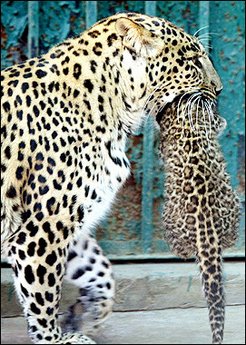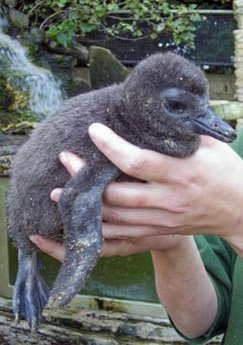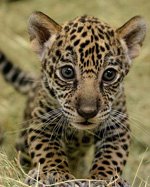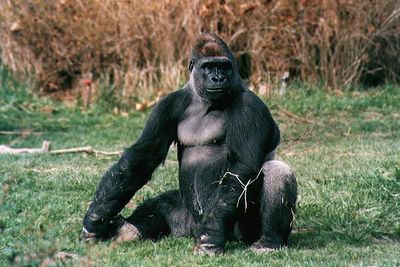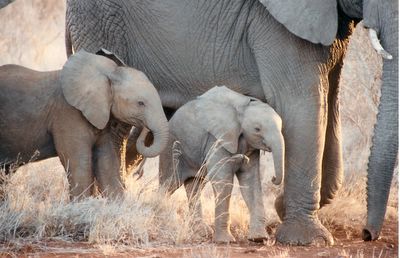
The Walt Disney World Resort's animal care team welcomed a 233 pound bundle of joy to Disney's Animal Kingdom earlier this week. The female African elephant calf arrived early Monday morning, and joins her 21-year-old mother Donna after 21 months (gestation) in the womb. The calf has not yet been named.
Both the calf and her mother are doing well according to veterinarians and elephant managers, who are cautiously optimistic about the calf's likelihood for survival. The first-time mother experienced a very short labour, lasting approximately 16 minutes. With assistance from the animal care team, the newborn became comfortable using her "newly-discovered" legs and began nursing successfully from Mom soon after her birth. She is already feisty and very active.
"African elephants are endangered and difficult to breed, and having a successful birth is a significant event both for the species and for our talented and experienced team of elephant experts who have been working on this breeding program for more than five years," said Dr. Beth Stevens, vice president of Disney's Animal Kingdom Theme Park and President of the American Zoo and Aquarium Association (AZA). Donna, who is on permanent loan from the Albuquerque Zoo, became pregnant through natural breeding on March 17, 2004, when she mated with Jackson, a bull here on breeding loan from the Pittsburgh Zoo. This arrangement is part of the AZA Elephant Species Survival Plan (SSP), a consortium of zoos and wildlife parks working cooperatively to conserve elephants.
The next critical milestone is for the calf to continue the bonding process with her mother who will teach her important lessons and protect her as she is introduced to the herd," said John Lehnhardt, animal operations director for Disney's Animal Kingdom Theme Park.
Going forward, the focus of the elephant managers and veterinarians at Disney's Animal Kingdom will be on the health and welfare of the calf and Donna.
In the near future, Guests will be able to see the calf's progress on camera monitors at Rafiki's Planet Watch at Disney's Animal Kingdom. It will be several weeks before the calf and her mother will join other elephants on the savanna.
Lehnhardt noted that breeding African elephants is a challenging process, so it is especially exciting that this is the third African elephant to be born at Disney's Animal Kingdom Theme Park. A male calf, Tufani, was born in May 2003 and has gained nearly 1500 pounds in his first two and a half years and Kianga a female was born in July 2004 has gained more than 500 pounds in her first year. Lehnhardt said because many of the elephants giving birth in zoos and wildlife parks are first-time mothers -- just as several of the elephant cows at Disney's Animal Kingdom are -- it is not unusual for the animals (both in the wild and in wildlife parks) to lose their first calf, either through a still birth or following the birth. He is optimistic that observation and interaction with Tufani has helped the other elephants gain additional maternal knowledge, thus improving the success rate for the Animal Kingdom breeding program.
Importance of Breeding Programs
African elephants are classified as endangered species by IUCN, the World Conservation Union, and their future in zoos and wildlife parks is complicated as the aging pachyderm population in North American zoos passes its reproductive prime.
Disney's Animal Kingdom has a breeding program that is part of a cooperative effort coordinated by the AZA that is focused on sustaining the elephant population in North America.
AZA's Elephant Species Survival Plan (SSP) has called for a five-fold increase in African elephant reproduction efforts -- using both natural and artificial breeding methods -- in order to create a self-sustaining elephant population among North American zoos and wildlife centers.
Preparing for a newborn
In the same way that people prepare their homes for a newborn baby, the staff at Disney's Animal Kingdom took steps to "baby proof" the elephant habitat to ensure that there were no hazards for a young elephant calf. The team has taken a critical look at the habitat and made many changes including planting more trees and shrubbery for shading purposes, closing gaps between boulders, and the installation of a shallow pool behind-the-scenes where the
calf will be able to explore the water and learn to swim in a safe environment.
High Tech Pregnancy
Donna received extensive pre-natal care during her pregnancy. In addition to regular ultrasounds, veterinarians and elephant managers monitored her hormonal levels on a daily basis to help them determine when she would give birth. She has been receiving around-the-clock attention from the animal care team over the past few weeks as the birth became imminent.
Disney's Animal Kingdom Theme Park is accredited by the American Zoo and Aquarium Association (AZA). With its more than 200 accredited members, AZA is a leader in global wildlife conservation, and your link to helping animals in their native habitats. For more information visit www.aza.org.
For further information: Media Contact: Ren? d'Entremont, Publicist,
The Walt Disney Company (Canada), Parks & Resorts, (416) 596-3356











